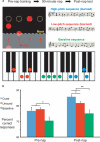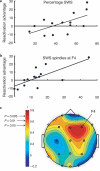Cued memory reactivation during sleep influences skill learning
- PMID: 22751035
- PMCID: PMC3498459
- DOI: 10.1038/nn.3152
Cued memory reactivation during sleep influences skill learning
Abstract
Information acquired during waking can be reactivated during sleep, promoting memory stabilization. After people learned to produce two melodies in time with moving visual symbols, we enhanced relative performance by presenting one melody during an afternoon nap. Electrophysiological signs of memory processing during sleep corroborated the notion that appropriate auditory stimulation that does not disrupt sleep can nevertheless bias memory consolidation in relevant brain circuitry.
Figures


References
-
- Diekelmann S, Born J. The memory function of sleep. Nature Neuroscience. 2010;11:114–126. - PubMed
-
- Wilson MA, McNaughton BL. Reactivation of hippocampal ensemble memories during sleep. Science. 1994;265:676–679. - PubMed
-
- Walker MP, Brakefield T, Morgan A, Hobson JA, Stickgold R. Practice with sleep makes perfect: sleep-dependent motor skill learning. Neuron. 2002;35:205–211. - PubMed
-
- Huber R, Ghilardi MF, Massimini M, Tononi G. Local sleep and learning. Nature. 2004;430:78–81. - PubMed
Publication types
MeSH terms
Grants and funding
LinkOut - more resources
Full Text Sources
Other Literature Sources
Medical
Research Materials

